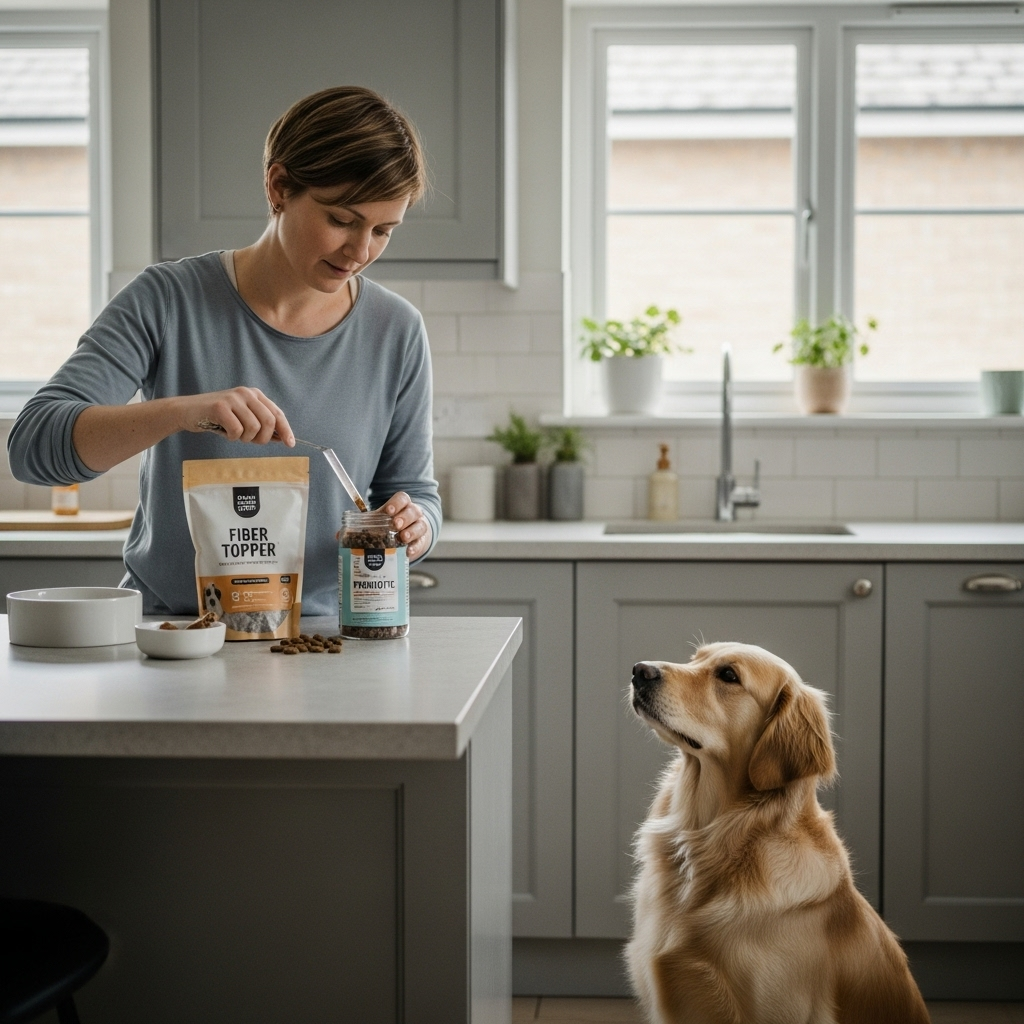Anal Gland Support: Fiber + Probiotics for Dogs

If your dog struggles with recurring anal gland problems — scooting, licking, or needing frequent manual expression — you may have heard that a combination of fiber and probiotics can help. This page explains how fiber and probiotics work together to support stool quality and gut health, how to choose and introduce products safely, what to expect, and when to see your veterinarian.
Why fiber plus probiotics?
Anal gland issues in dogs are often related to stool consistency. When stools are too loose, they may not exert enough pressure on the anal sacs during bowel movements to naturally express the glands. Adding dietary fiber can help bulk and firm stools so the glands empty more effectively. Probiotics support a balanced gut microbiome, which can reduce episodes of diarrhea and improve overall digestive function. Together, a fiber + probiotics approach addresses both the mechanical (stool bulk) and microbial (gut flora) factors that commonly contribute to anal gland trouble.
How fiber helps
- Increases stool bulk and firmness, encouraging natural expression of anal glands.
- Helps regulate intestinal transit time — soluble fiber can soften very hard stools while insoluble fiber increases bulk.
- May reduce irritation and inflammation associated with chronic scooting or licking when stools are normalized.
How probiotics help
- Supports a healthy balance of intestinal bacteria, which can reduce diarrhea and gas.
- May improve digestion of nutrients and stabilize stool frequency and consistency.
- Certain strains commonly used in dogs include Enterococcus faecium, Lactobacillus spp., and Bifidobacterium spp.; look for products formulated specifically for canines.
Choosing the right fiber + probiotics combination
Products come as combined supplements, or you can use separate fiber and probiotic items. Key considerations:
- Veterinary formulation: Choose products labeled for dogs rather than human supplements to avoid inappropriate doses or harmful ingredients (e.g., xylitol in human chewables).
- Type of fiber: Soluble fibers (psyllium, beet pulp) retain water and can soften overly firm stools; insoluble fibers (cellulose) add bulk and speed transit. Many commercial blends use a mix for balanced effects.
- Probiotic strains and CFU: Look for multi-strain formulas with clinically used canine strains and a guaranteed CFU count at the time of expiration or at least at the time of manufacture. Higher CFU is not always better — appropriate strains matter more than extreme counts.
- Form: Powders are easy to mix into food; chews and capsules may be more convenient for some dogs. Refrigeration is recommended for some probiotics but not required for all; follow label instructions.
How to introduce fiber and probiotics safely
- Talk to your veterinarian first—especially if your dog has medical issues (pancreatitis, inflammatory bowel disease, immune compromise) or is on other medications.
- Start slowly. Add a small amount of fiber and the probiotic at a low dose and increase gradually over 7–14 days to reduce gas or bloating.
- Monitor stool quality and frequency. Keep a simple log of stool firmness (use a scale like the dog stool scoring chart) and symptoms like scooting or licking.
- Adjust as needed. If stool becomes too firm or your dog shows intolerance (vomiting, persistent diarrhea), pause and consult your vet.
- Use as part of a comprehensive plan. Fiber + probiotics can help prevent recurrence but aren’t a substitute for treating infections, abscesses, or severe impactions that require professional veterinary care.
When to see the vet
Seek veterinary attention promptly if your dog has: severe pain around the tail base, blood or pus in stool, fever, a visible abscess, sudden worsening of symptoms, or if conservative measures don’t help in a few weeks. Chronic or recurring anal gland disease may require diagnostics (cytology, culture, imaging), antibiotics, flushing, or surgical options in some cases.
Pros and Cons
| Pros | Cons |
|---|---|
| Can firm stools and reduce need for manual expression | Possible initial gas, bloating, or altered appetite when starting |
| Supports gut health and reduces diarrhea episodes | Not a guaranteed cure for infected or abscessed glands |
| Many convenient forms (powders, chews, mixed foods) | Quality varies — lower-quality products may be ineffective |
Monitoring progress: realistic expectations
Some dogs show improvement in stool consistency and reduced scooting within a few days to a couple of weeks. In other dogs, changes may take 4–8 weeks to become clear. If your dog needed frequent manual expression before starting fiber + probiotics, you may see a reduction in frequency over time but occasional manual expression could still be necessary. Always use these measures as part of a broader plan including diet review, weight management, and veterinary follow-up.
FAQ
Q: How long before I see improvement?
A: Some dogs improve in days; others take several weeks. Monitor stool consistency and symptoms for at least 2–8 weeks to judge effectiveness.
Q: Can probiotics alone fix anal gland problems?
A: Probiotics can reduce diarrhea and support gut health, but probiotics alone may not resolve anal gland issues caused by stool consistency. Combining probiotics with appropriate fiber is often more effective.
Q: Are there risks to giving fiber and probiotics?
A: Most dogs tolerate them well, but initial gas, mild diarrhea, or constipation can occur if doses are increased too quickly. Dogs with certain medical conditions or immune compromise need veterinary guidance before starting supplements.
Q: Can I use human probiotic products?
A: It’s safer to use products formulated for dogs. Human products may contain sweeteners like xylitol or strains/doses that aren’t appropriate for canines.
Key Takeaways
- Fiber helps firm and bulk stools so anal glands can empty naturally.
- Probiotics support a healthy gut and reduce diarrhea that can worsen anal gland problems.
- Use dog-specific products, introduce slowly, and monitor stool quality.
- Not a substitute for veterinary care—see your vet for infections, abscesses, or persistent problems.
- Expect gradual improvement; adjust plan with professional guidance if needed.
Note: This information is educational and not a diagnosis. If your dog shows severe symptoms or you’re unsure about starting supplements, contact your veterinarian.
Disclaimer: The content above is intended for general informational purposes and does not replace professional veterinary advice. Always consult your veterinarian before starting new supplements or making significant dietary changes for your pet.

Leave a Reply